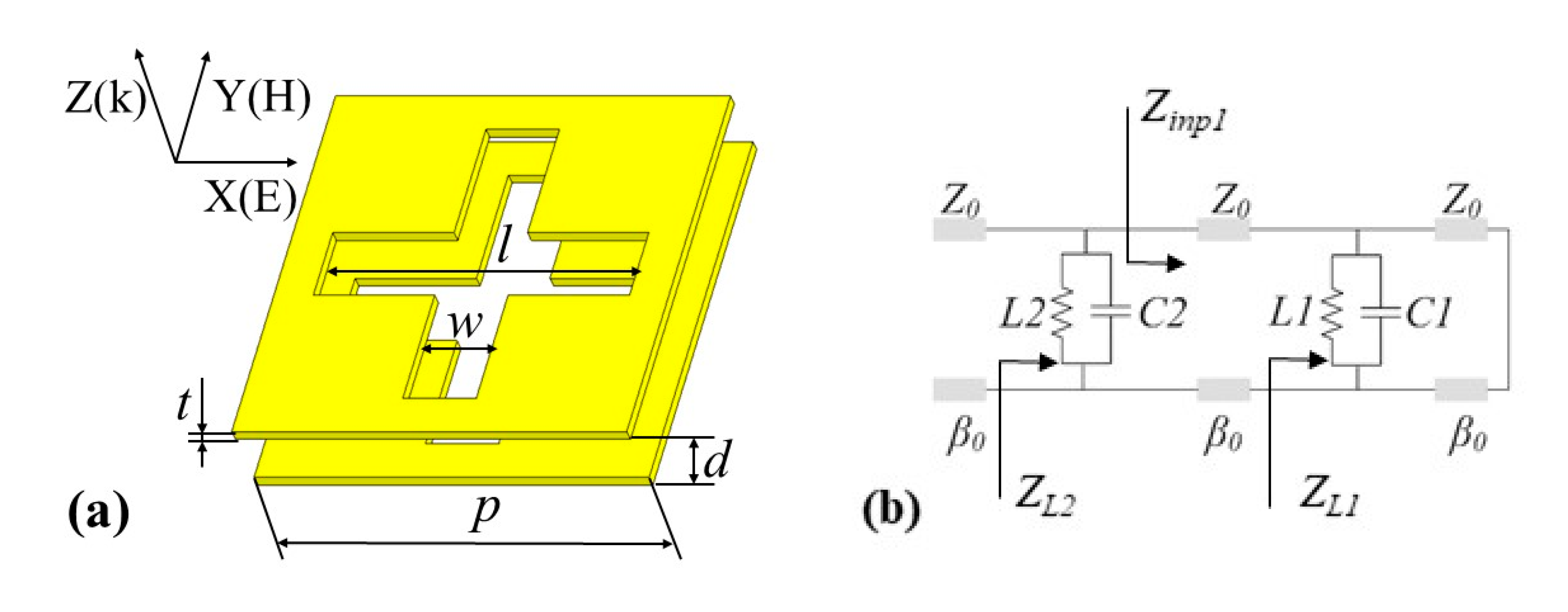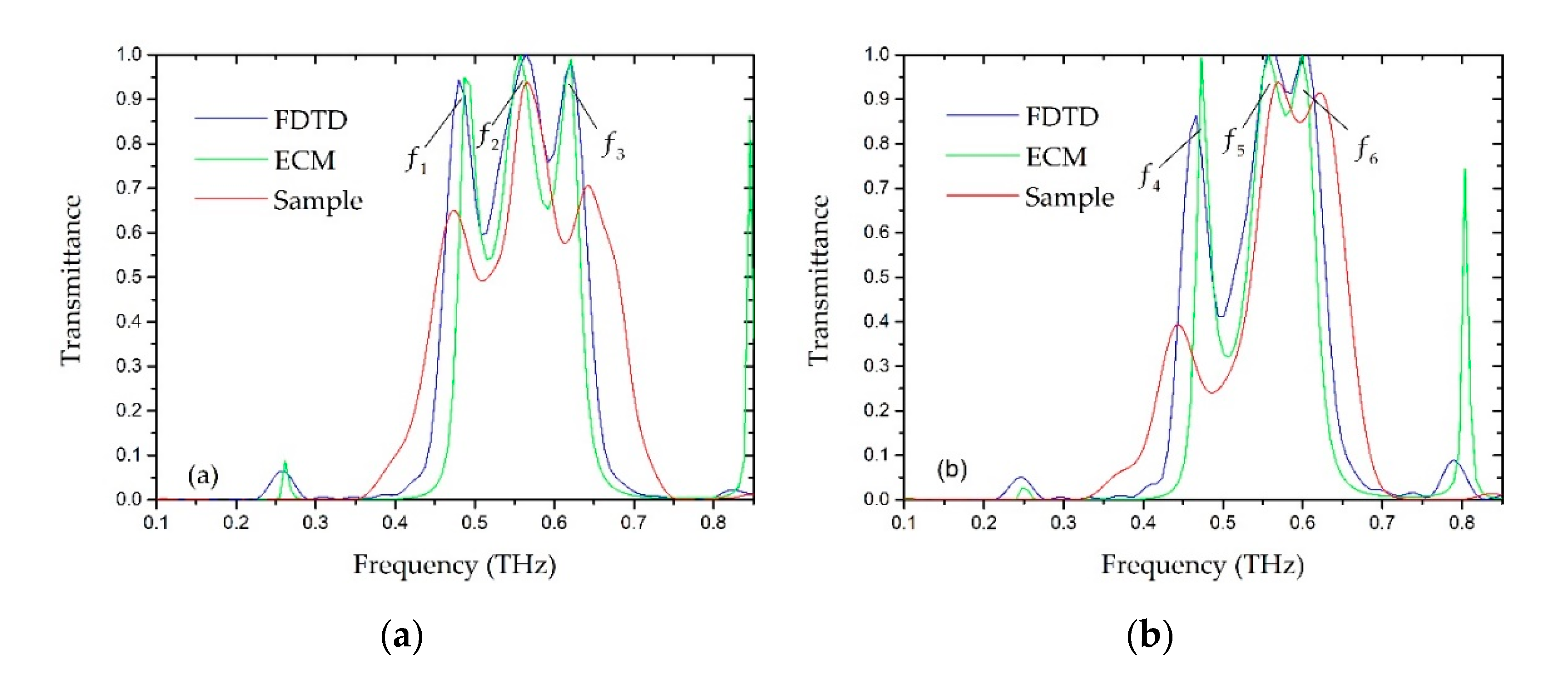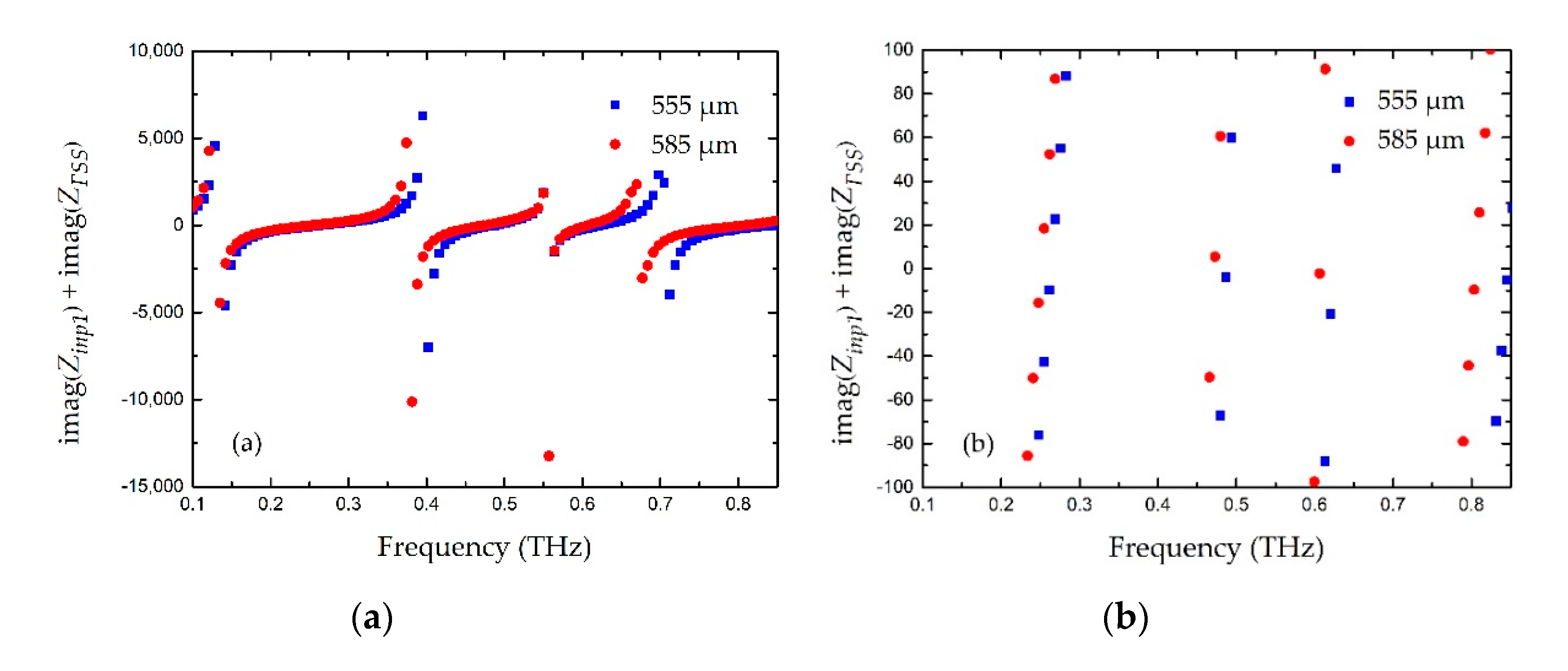Resonant Coupling Effects in a Double-Layer THz Bandpass Filter
Abstract
:Featured Application
Abstract
1. Introduction
2. Theory and Experiments
3. Results and Discussion
4. Conclusions
Author Contributions
Funding
Conflicts of Interest
References
- Mittleman, D.M. Perspective: Terahertz science and technology. J. Appl. Phys. 2017, 122, 230901. [Google Scholar] [CrossRef]
- Zangeneh-Nejad, F.; Safian, R. A graphene-based THz ring resonator for label-free sensing. IEEE Sens. J. 2016, 16, 4338–4344. [Google Scholar] [CrossRef]
- Zangeneh-Nejad, F.; Safian, R. Hybrid graphene–molybdenum disulphide based ring resonator for label-free sensing. Opt. Commun. 2016, 371, 9–14. [Google Scholar] [CrossRef]
- Rahm, M.; Li, J.S.; Padilla, W.J. Thz wave modulators: A brief review on different modulation techniques. J. Infrared Millim. Terahertz Waves 2013, 34, 1–27. [Google Scholar] [CrossRef]
- Yarahmadi, M.; Moravvej-Farshi, M.K.; Yousefi, L. Subwavelength graphene-based plasmonic THz switches and logic gates. IEEE Trans. Terahertz Sci. Technol. 2015, 5, 725–731. [Google Scholar] [CrossRef]
- Zangeneh-Nejad, F.; Safian, R. Significant enhancement in the efficiency of photoconductive antennas using a hybrid graphene molybdenum disulphide structure. J. Nanophotonics 2016, 10, 036005. [Google Scholar] [CrossRef]
- Zangeneh-Nejad, F.; Fleury, R. Topological analog signal processing. Nat. Commun. 2019, 10, 2058. [Google Scholar] [CrossRef]
- Zhang, H.; Guo, P.; Chen, P.; Chang, S.; Yuan, J. Liquid-crystal-filled photonic crystal for terahertz switch and filter. J. Opt. Soc. Am. B 2009, 26, 101–106. [Google Scholar] [CrossRef]
- He, J.; Liu, P.; He, Y.; Hong, Z. Narrow band-pass tunable terahertz filter based on photonic crystal cavity. Appl. Opt. 2012, 51, 776–779. [Google Scholar] [CrossRef]
- Zhou, X.; Yin, X.; Zhang, T.; Chen, L.; Li, X. Ultrabroad terahertz band-pass filter by hyperbolic metamaterial waveguide. Opt. Express 2015, 23, 11657–11664. [Google Scholar] [CrossRef]
- Hu, F.; Fan, F.; Zhang, X.; Jiang, W.; Chen, Y.; Li, P.; Yin, X.; Zhang, W. Intensity modulation of a terahertz band-pass filter: Utilizing image currents induced on MEMS reconfigurable metamaterials. Opt. Lett. 2018, 43, 17–20. [Google Scholar] [CrossRef]
- Papari, G.P.; Koral, C.; Andreone, A. Geometrical dependence on the onset of surface plasmon polaritons in thz grid metasurfaces. Sci. Rep. 2019, 9, 924. [Google Scholar] [CrossRef] [PubMed] [Green Version]
- Papari, G.P.; Nivas, J.J.J.; Koral, C.; Allahyari, E.; Andreone, A. Engineering of high quality factor THz metasurfaces by femtosecond laser ablation. Opt. Laser Technol. 2020, 128, 106159. [Google Scholar] [CrossRef]
- Gao, B.; Ren, Z.; Lin, Y.; Chen, Y.; Wang, X. Design and verification of an integrated free-Standing thick-screen FSS radome. IEEE Antennas Wirel. Propag. Lett. 2018, 17, 1630–1634. [Google Scholar] [CrossRef]
- Lin, Y.; Yao, H.; Ju, X.; Chen, Y.; Zhong, S.; Wang, X. Free-standing double-layer terahertz band-pass filters fabricated by femtosecond laser micro-machining. Opt. Express 2017, 25, 25125–25134. [Google Scholar] [CrossRef] [PubMed]
- Chen, K.; Li, Z.; Liu, J.; Duan, R.; Wang, Y.; Zhang, W.; Cai, B.; Chen, L.; Zhu, Y. A study of FSS in terahertz range for polarization modulation purpose. IEEE Photonics Technol. Lett. 2013, 25, 1613–1615. [Google Scholar] [CrossRef]
- Vegesna, S.; Zhu, Y.; Bernussi, A.; Saed, M. Terahertz two-layer FSSs with improved transmission characteristics. IEEE Trans. Terahertz Sci. Technol. 2012, 2, 441–448. [Google Scholar] [CrossRef]
- Ebrahimi, A.; Nirantar, S.; Withayachumnankul, W.; Bhaskaran, M. Second-order terahertz bandpass FSS with miniaturized elements. IEEE Trans. Terahertz Sci. Technol. 2015, 5, 761–768. [Google Scholar] [CrossRef]
- Rao, L.; Yang, D.; Zhang, L.; Li, T.; Xia, S. Design and experimental verification of terahertz wideband filter based on double-layered metal hole arrays. Appl. Opt. 2012, 51, 912–916. [Google Scholar] [CrossRef]
- Miyamaru, F.; Hangyo, M. Anomalous terahertz transmission through double-layer metal hole arrays by coupling of surface plasmon polaritons. Phys. Rev. B 2005, 71, 165408. [Google Scholar] [CrossRef]
- Kaipa, C.S.R.; Yakovlev, A.B.; Medina, F.; Mesa, F.; Hibbins, A.P. Circuit modeling of the transmissivity of stacked two-dimensional metallic meshes. Opt. Express 2010, 18, 13309–13320. [Google Scholar] [CrossRef] [PubMed]
- Barzegar-Parizi, S. Analysis of stacked structures composed of arrays of thick slits: An accurate analytical circuit model. Plasmonics 2018, 13, 1711–1719. [Google Scholar] [CrossRef]
- Molero, C.; Rodríguez-Berral, R.; Mesa, F.; Medina, F. Wideband analytical equivalent circuit for coupled asymmetrical nonaligned slit arrays. Phys. Rev. E 2017, 95, 023303. [Google Scholar] [CrossRef]
- Kaipa, C.S.R.; Yakovlev, A.B.; Medina, F.; Mesa, F. Transmission through stacked 2D periodic distributions of square conducting patches. J. Appl. Phys. 2012, 112, 033101. [Google Scholar] [CrossRef] [Green Version]
- Costa, F.; Monorchio, A.; Manara, G. An Overview of Equivalent Circuit Modeling Techniques of Frequency Selective Surfaces and Metasurfaces. ACES J. 2014, 29, 960–976. [Google Scholar]
- Gao, M.; Abadi, S.; Behdad, N. A dual-band, inductively-coupled miniaturized-element FSS with higher-order bandpass response. IEEE Trans. Antennas Propag. 2016, 64, 3729–3734. [Google Scholar] [CrossRef]
- Hokmabadi, M.P.; Wilbert, D.S.; Kung, P.; Kim, S.M. Design and analysis of perfect terahertz metamaterial absorber by a novel dynamic circuit model. Opt. Express 2013, 21, 16455–16465. [Google Scholar] [CrossRef]
- Langley, R.J.; Parker, E.A. Equivalent circuit model for arrays of square loops. Electron. Lett. 1982, 18, 294–296. [Google Scholar] [CrossRef]
- Pozar, D.M. Microwave Engineering; John Wiley & Sons: New York, NY, USA, 2011; pp. 189–192. [Google Scholar]
- Frickey, D.A. Conversions between S, Z, Y, H, ABCD, and T parameters which are valid for complex source and load impedances. IEEE Trans. Microw. Theory Tech. 1994, 42, 205–211. [Google Scholar] [CrossRef]
- Chen, Y.Q.; Gao, B.P.; Lin, Y.Z.; Ju, X.W.; Wang, J.; Wang, X.F. Metal wire grid THz polarizer fabricated by femtosecond laser micro-machining. Chin. J. Lasers 2018, 45, 0802005. [Google Scholar] [CrossRef]
- Wood, R.W. On a remarkable case of uneven distribution of light in a diffraction grating spectrum. Philos. Mag. 1902, 4, 269–275. [Google Scholar] [CrossRef] [Green Version]




© 2020 by the authors. Licensee MDPI, Basel, Switzerland. This article is an open access article distributed under the terms and conditions of the Creative Commons Attribution (CC BY) license (http://creativecommons.org/licenses/by/4.0/).
Share and Cite
Gao, T.; Huang, F.; Chen, Y.; Zhu, W.; Ju, X.; Wang, X. Resonant Coupling Effects in a Double-Layer THz Bandpass Filter. Appl. Sci. 2020, 10, 5030. https://doi.org/10.3390/app10155030
Gao T, Huang F, Chen Y, Zhu W, Ju X, Wang X. Resonant Coupling Effects in a Double-Layer THz Bandpass Filter. Applied Sciences. 2020; 10(15):5030. https://doi.org/10.3390/app10155030
Chicago/Turabian StyleGao, Tao, Feng Huang, Yanqing Chen, Weilin Zhu, Xuewei Ju, and Xiangfeng Wang. 2020. "Resonant Coupling Effects in a Double-Layer THz Bandpass Filter" Applied Sciences 10, no. 15: 5030. https://doi.org/10.3390/app10155030




